Final Report for FNE16-843
Project Information
This project was a continuation of experiments to improve the efficiency of ground cherry harvest, for the purpose of reducing labor and increasing their viability as a fresh market and value-added crop. Previous experiments established that pruning and trellising, in combination with a net trough to catch the fruit (PTN), improved the quality of the fruit, reduced labor and amount of time taken for harvest, however, yields suffered due to delayed fruiting. In order to address this delay, we trialed three earlier start times for nursery transplants compared to the standard 6 weeks prior to transplanting as a control, with the pruning process beginning prior to field transplant. Additionally, Ground cherry scions were grafted to Tomatillo rootstock in the hopes of creating a more upright architecture for the plants, thus negating the need for PTN. Grafting has also been known to hasten maturity in some plants. Time, yield, and quality data was collected twice a week during the harvest season.
We were not able to directly compare yields between the treatments, due to unexpected high pest issues, and unfavorable weather conditions, however, the PTN treatment, again, was favorable in terms of improving harvest efficiency and fruit quality. Transplants started earlier in the nursery did have higher, earlier yields than the previous year’s trials, though still not as heavy as the control treatment. Fruit from pruned plants were larger and of higher quality and harvest was less labor and time intensive.
Only 5 of the 31 grafts survived for field production, with the transition from grafting chamber to field being the point of major losses. While the results of grafting Ground cherry scion to Tomatillo rootstock were not fruitful in improving plant architecture, rate of maturity (producing earlier yields) or fruiting characteristics, the healing chamber design worked very well, and could be used for other grafts, like tomatoes, where protocols have already been established.
Outreach was conducted at a Twilight Tour of the Lower Eastern Shore Research and Education Center, in Salisbury, Maryland.
Introduction:
Calliope Farm is a small farm, located on the Delmarva Peninsula in Maryland. We specialize in growing a wide variety of regional, ethnic and exotic vegetables, year-round, for farmers markets, a Community Supported Agriculture (CSA) program, and restaurants. In our eight years of operation, Ground cherries (Physalis pruinosa) have been a favorite of market customers, CSA members, and chefs; however, the labor of harvest, which entails picking up large quantities of small fruit, off of the ground, has limited our ability to meet the high demand. In an effort to make harvesting more efficient and eliminate ground contact, we have developed a pruning, trellising, netting technique (PTN) that showed promise in a 2015, SARE funded trial. The previous trial resulted in higher quality fruit, and reduced labor, but the heavy pruning that was required in order to make the plants more upright, for trellising, removed large portions of the plant, reducing early yields. In order to address this problem, we experimented with earlier nursery stock start times, and pruning prior to field transplant.
The objectives of second year trials were to:
- Identify whether starting transplant earlier, in the nursery, would result in larger, more mature transplants that could produce early season yields commensurate with control (non-PTN) plants.
- Identify how much earlier plants would need to be started: 2, 4, or 6 weeks, to reach high early season yields.
- Attempt grafting Ground cherry scion to Tomatillo rootstock to create a more upright architecture that would minimize, or eliminate the need for PTN.
- Compare yields, and harvest times of PTN and grafted plants, with traditionally grown (control) plants.
Cooperators
Research
Four sowings of Cossack pineapple Ground cherries were planted on the following dates, using 128 trays on a heated germination mat: Feb. 19 (T1), March 3 (T2), March 18 (T3), and April 1(T4), 2016. The final sowing, T4, represents the standard, recommended start time of six-weeks prior to field transplant, and was used as the control. All nursery stock was upsized in to larger pots as needed, early flowers were pinched off, and the earliest plantings, T1 and T2, had some early pruning. Some transplants were lost to freezing, when we experienced a power failure in the nursery.
On May 27, treatments 1-4 were transplanted to 3’x100’ raised beds, on black ground cover with drip irrigation, at the Lower Eastern Shore Research and Education Center. Plant spacing was 2’ apart, in row. This date was two weeks later than planned, due to cold temperatures and wet conditions that deterred bed preparation. The aforementioned loss of transplants due to freezing resulted in fewer than the intended 50 plants per treatment. The final number of plants was as follows: T1-32, T2-33, T3-44, And T4-44. Treatment beds 1-3 had stakes driven every five feet, to support two plants between every set, and plants were pruned, as needed, to create a more upright habit that allowed plants to be supported, using tomato clips to attach branches to twine. Crosspieces were attached to every other stake, creating a “T” shape, and a trough was created by cutting a 7’x100’ piece of insect netting lengthwise, and attaching it underneath the plant canopy, and to the crosspieces. The netting was used to catch the fruit, eliminating contact with the ground, and making the fruit easier to harvest.
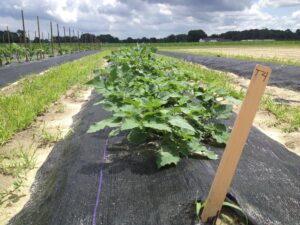
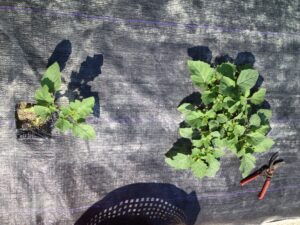
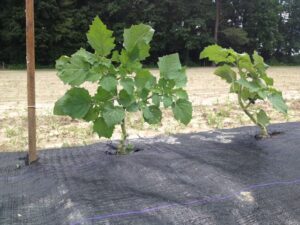
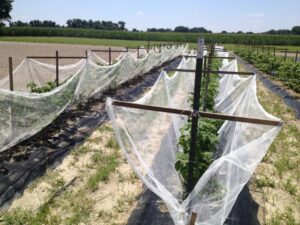
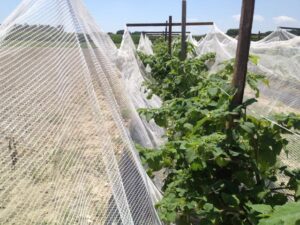
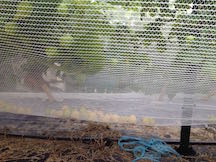
Images: Top left- before and after first pruning in field.Top middle- No PTN Top right- Ground cherries clipped to first line of string. Botom left- Ground cherries with PTN installed. Bottom middle- Ground cherries with PTN. Bottom right- Fruit caught in net trough.
For the grafting portion of the project, Verde Puebla Tomatillo, intended for rootstock, were sown on March 3, with the Ground cherries intended for use as scions sown on March 11. In previous experiments it was determined that a week between sowings would provide more uniform stem diameters, which would make grafting easier, and more successful.
On May 6, 31 Ground cherry scions were grafted to Tomatillo rootstock. A Holder, Feather grafting knife, which makes uniform cuts at a 45 degree angle, was used to remove the scion from the Ground cherries and remove the tips from the Tomatillos, making sure to choose plants whose stem diameters matched. 2mm grafting clips were used to hold the graft in place during the healing process.
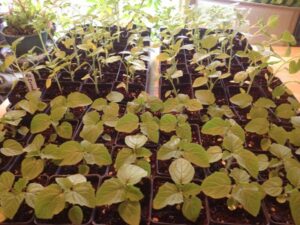
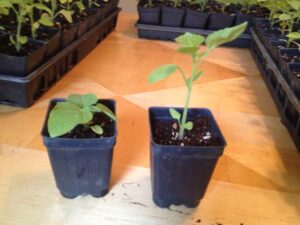
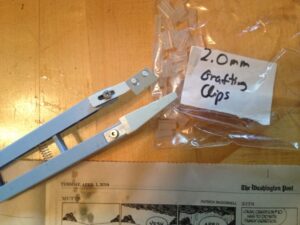
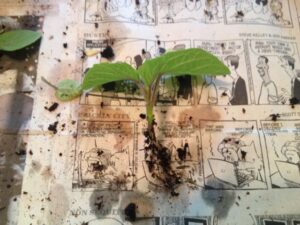
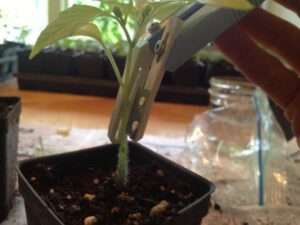
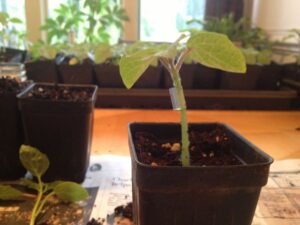
Images: Top right- Ground cherry and Tomatillo nursery stock, for grafting. Top middle- Ground cherry transplant (left) and Tomatillo transplant (right). Top right- Holder, Feather grafting knife, and grafting clips. Bottom left- Ground cherry. Bottom middle- Tomatillo transplant being cut at 45 degree angle. Bottom right- Ground cherry scion attached to Tomatillo rootstock.
All plants were placed in a grafting chamber, constructed from pvc pipe, a refrigerator drain pan, and wrapped in plastic. The chamber was kept in an approx. 85 degree, 90% humidity environment. The process used followed recommendations for grafting tomato plants. While early results were good, only five of the grafted plants survived to the field transplant stage; these were planted in the same manner as T1-T3.

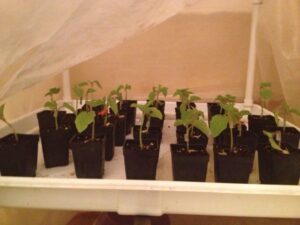
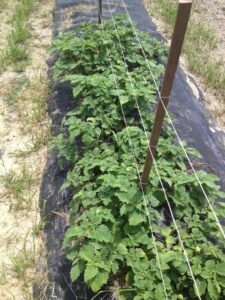
Images: Left- Grafting healing chamber. Middle- Grafted plants in healing chamber. Right- Grafted plants in the field.
Ground cherry plants, started in nursery trays/flats, are in a hurry to flower, and it is difficult to keep them in the vegetative stage, although, once planted to the field, they will resume vigorous vegetative growth.
Early pruning, in the nursery transplant stage, resulted in more branching and plants still needed significant pruning once transplanted to the field. Plants started earlier in the nursery did start producing fruit earlier than the previous year’s trial, when all transplants (pruned and un-pruned) were started at the same time.
Five, out of thirty-one grafted plants survived to be field transplanted. Numbers were initially much higher, but plants seemed to have difficulty acclimating outside of the healing chamber environment. The technique used, and expected time frame, was following recommendations for grafting tomatoes. It is possible that more successful union between Tomatillo and Ground cherry requires a different approach. Ultimately, the plants that did get field transplanted did not seem to have benefited, in either improved architecture, or fruit characteristics.
As in the previous year, fruit from pruned plants was larger and of higher quality. Harvest was less labor and time intensive, and preferred by myself, and my helper. However, yields were still lower than un-pruned plants. Yields were, in general, lower than in previous years, due to weather and pest problems.
Three striped potato beetles (TSPB) caused a significant amount of damage and defoliation to all treatments. We attempted to spray plants with Monterey Garden Spray (spinosad), but this had limited affect. In spite of consistent monitoring for TSPB throughout the growing period, these bugs are difficult to control once they become established. There seemed to be two waves of the TSPB: the eggs that appear on the undersides of leaves, in the nursery, and at transplant time, are easy to monitor for and remove- this early wave may originate from an over-wintered population, as it is known that their close relative, the Colorado Potato Beetle (CPB) can overwinter in the soil. It appeared, for the first month/six weeks of growth, that TSPB were under control, however, the population increased mid-summer, possibly as a result of a migratory population. Larger plant size, and abundance of foliage made it more difficult to find and remove eggs thoroughly once plants were mature. In addition, TSPB are fast flyers, and so the adults are more difficult to catch than their slower relative, CPB. Because TSPB do not threaten any major crops in the U.S., information on how to control them is limited, and recommendations are the same as controls for CPB, which was not effective.
Harvest time and yield data were collected throughout the harvest period (July 26-August 26) and are as follows:
T1- 31#/3.45 hours
T2- 20.39#/2.27 hours
T3- 28.61#/4.25 hours
T4- 78.32#/10.78 hours
Graft- 3.09#/.66 hours
The per plant yields/harvest times, adjusted for the variability of plant number per treatment, are:
T1- .97#/.11 hours
T2- .62#/.08 hours
T3- .65#/.09 hours
T4- 1.78#/.25 hours
Graft- .61#/.13 hours
As compared to the control (T4), the treatments yielded T1-54%, T2-35%, T3-37%, and Graft-34%.
Per plant harvest times, as compared to the T4 were: T1- 44%, T2-32%, T3- 36%, and Graft- 52%.
An additional 11 hours was spent Hours installing/applying PTN for treatments T1-T3.
However, due to loss of plants from bug damage, the data is not an accurate representation. Because the plants drop their fruit on the ground, or into the collective trough, it is impossible to distinguish which plant the fruit came from. There was a considerable loss of yield due to defoliation, and so, basing calculations on the original number of plants would be suspect.
We were not able to directly compare yields between the treatments, due to pest issues, and unfavorable weather conditions, however, the PTN treatment, again, was favorable in terms of improving harvest efficiency, and fruit quality. Transplants started earlier in the nursery did have higher, earlier yields than the previous year’s trials, though still not as heavy as the control treatment.
While the results of grafting Ground cherry scion to Tomatillo rootstock were not fruitful in improving plant architecture, or producing earlier yields, the healing chamber design worked very well, and could be used for other grafts, like tomatoes, where protocols have already been established.
Education & Outreach Activities and Participation Summary
Participation Summary:
Outreach was conducted at a twilight tour of the Lower Eastern Shore Research and Education Center. Approximately fifty attendees, consisting of Extension agents, Research and Extension faculty from University of Maryland, and local and state officials, toured the facility and were provided with samples of Ground cherries. The response was very positive, and many had never heard, or tried Ground cherries before.
In late-October, 2016 a presentation was given for faculty and graduate students of the Agriculture Department at University of Maryland Eastern Shore.
Additionally, information on the PTN technique has been provided to several growers, who have contacted me via email, after reading about the 2015 Ground cherry experiments.
Project Outcomes
Potential Contributions
While the last experiment did not yield quantifiable results, I believe there is still promise in the PTN technique. The larger fruit size, higher fruit quality, improved food-safety and reduced labor are characteristics that justify further inquiry. Unfortunately, 2016 was not hospitable for that purpose. Earlier start times did seem to correlate with earlier yields, however, nursery transplants need to be upsized several times, and flowers pinched, in order to keep the plants in a vegetative state, so that when transplanted, growth resumes unhindered by stress or shock.
Grafting between Tomatillo and Ground cherry, or at least between the particular varieties chosen, does not seem to have any effect on the architecture of the plant, rate of maturity, or fruiting characteristics.
There has continued to be a great demand for Ground cherries, and many growers were interested in purchasing large quantities to supply their Community Supported Agriculture members.
Future Recommendations
While further experimentation with earlier transplant start times, and the PTN technique have potential in solving the issue of intense harvest labor, once established, an intermediate solution may be to have a small early planting of un-PTN plants, to fill early season demand, while PTN plants supply mid- and late-season demand. The earlier planting could also be used as a trap-crop, which, if flamed, or sprayed, could eliminate some of the TSPB. This could be especially effective if row cover is used on the PTN planting. Alternatively, row cover could be used to protect all plantings of Ground cherries.
More research and information is needed on TSPB, so that the growing demand for Ground cherries, and Tomatillos, which they also affect, may be met.
The grafting trials only included one variety each of Ground cherries and Tomatillos. While that particular combination was not useful in achieving the hoped-for benefits of improved architecture, and/or earlier maturation of fruit, it is possible that other unions could be more useful. In order to continue efforts in that direction, a grafting protocol, specific to Ground cherries and Tomatillos, needs to be developed. The healing time, for instance, seemed to be longer than that of tomatoes, perhaps because the grafting was across species.